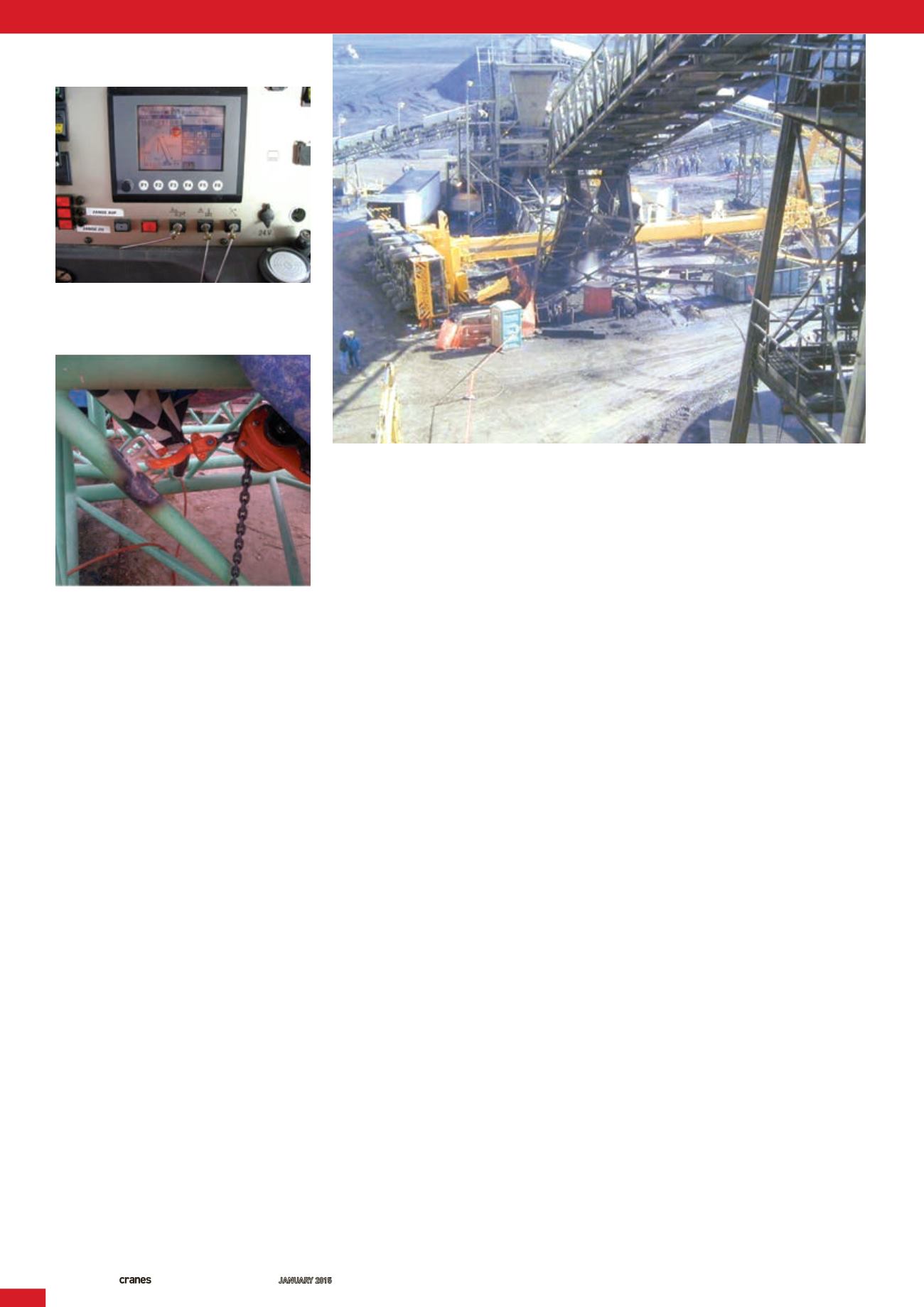
INTERNATIONAL ANDSPECIALIZED TRANSPORT
■
JANUARY 2015
26
CRANEACCIDENTS
“As a result,we implementeda large
numberof countermeasures toprevent
a situation like this from everhappening
again. The firstmeasurewas thepermanent
useof additionalmats, regardlessof the
ground.We alsoobtained information
about themost common soils found in
Denmarkand, as a result, groundbearing
capabilities became an integratedpart of
the customerorder.”
So the root cause for these typesof crane
accidents aredue to insufficient, orno
examinationor knowledge, of theground
and its loadbearing capabilities.As a result,
a lift shouldneverbe carriedout until full
knowledge about thegroundand its load
bearing capabilitieshasbeenobtained. Lifts
shouldalsoneverbeperformedwithout
usingadditional and sufficientmatsunder
theoutriggerpadsof the crane.
Groundpressure
Peoplemight have the impression that the
area coveredbya crawler cranedistributes
craneweight and the loadon thehook
evenly. Theway that the load isdistributed,
however, stronglydependson theposition
of the centreof gravity in relation to the
crawler tracks (seeFigure1).Adequate load
distributionunder crawlersby timbersor
mats is requiredaswell.
Crane accidents alsohappenduring the
erectionofwind turbines.Wind speeds, or
more accurately,windgusts, arean issue
that shouldbe clear to everyone today. This
knowledge is in theFEMguidancepaper
5.016
called
Guideline Safety Issues inWind
Turbine InstallationandTransportation
.
Theguidance is takenover intoEN13000
asmandatory content for instruction
manuals. Thekeymessages are simple: get
informationon theweight, the sail areaand
the shape factor, to evaluatewhether the
relationof loadand sail area falls into the
regulations, customers started tobuy
cranesone sizebigger thanbefore. So far
noaccidentswith tipped cranesorbroken
boomshavebeenobserved for cranes
equippedwithLMI systems fulfilling
EN13000:2010
– this is anobservation
sharednot onlybyallmanufacturers in
FEM, but alsoby theHSE representatives.
Outside influences
Poor ground conditions,where theground
is incapableof handling the load from the
outriggersor from the crawlers, is another
factor causing crane accidents. Everyone
knowswhy it goeswrong: the site for the
setupof the cranewasn’t carefully examined
for its loadbearing capabilities andpeople
didn’t take the time to findoutwhatwas
below the surface, for example, pipes and
sewer systems.Other factors include a lack
of additionalmatsunder theoutriggerpads
and the cranebeing set up too close toa
slope etc.
“It canbeverydifficult to establish the
correct loadbearing capabilitiesof any
given surface,” Jansen says. “For example,
around10years agowewereworkingon
a sitewhen thegroundunder the cranes’
outriggers gave inand the crane toppled
over.Wehadbeenon the same site all
through thewinter,workingwithbigger
cranes, but avoid (causedbyvibrations
fromhydraulicpilinghammers)had
developedonemetrebelow the surface.
Theverdict from thegovernment’shealth
and safety inspectorwas clear: Itwasour
responsibility, at all times, tohave full
informationabout theground conditions,
even ifwehad togo through expensive
ground examinationsprior tohoistingand
during thedurationof the job.
root cause for a specific accident should
take a lookat thepeople surrounding the
crane.Manufacturers can forever continue
toaddnew safety features to their cranes
but owners andoperatorsoften findaway
inwhich they candisable a safety feature if
it is standing in thewayof executinga job.
A crane is a tool tobeused for awide
rangeof jobs. Themore complex systems
become, however, the less reliable they tend
tobe.Adding safety features covering even
unlikely scenariosdoes add complexity.
Herewe are speakingabout technical
systemswhichareusedunder really tough
conditions, for example,wide temperature
ranges from -40 to+60degreesCelsius, in
totallydryor veryhumid environments.
The complexity in crane configuration,
crane applicationand environmental
conditions,makes it difficult to establish
safetydevices for all situations.
Overloading cranes
All new cranesdelivered inEurope after 1
May2010havehad tobe equippedwitha
new set up for the loadmoment indicator
(LMI) toprevent deliberateoverriding.
Formanyyears itwas abadhabit among
craneoperators and crane supervisors
todeliberatelydisable theLMI. Some
operatorshad theLMI constantlydisabled,
whileothersdid it routinelywhen they
came to the limit of the load chart; a
situation that properplanning could
haveprevented.
Since the introductionof thenew
(Left): Abent diagonal ona latticeboom section
that hadbeen subjected tounauthorised repair
This crane tippedover after itwas
movedwithnooutriggers extended
Cranes delivered inEuropeafter 1May 2010
havehad tobeequippedwithanew set up for
the loadmoment indicator (LMI)


